One of the reasons I went into teaching physical education is because I wanted to teach students the power of the mind-body connection. I wanted them to develop strength not only in physical skills, but in the mental skills as well.
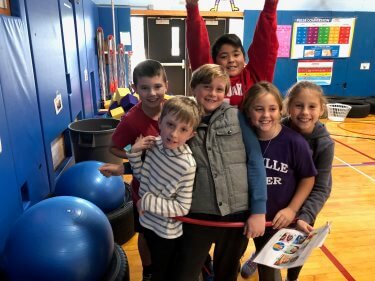
I also want my students to learn that our thoughts, feelings, beliefs, and attitudes can positively or negatively affect our biological functioning. In other words, our minds can affect how healthy our bodies are. The opposite is true as well. The things we do with our physical body (e.g. what we eat, how much we exercise, how many hours of sleep we get) can impact our mental state, positively or negatively. This results in a complex relationship between our mind and body.
When I was younger, I struggled with anxiety, depression, and panic attacks. I would allow negative thoughts to control me. I struggled with my own self-worth and I had a lot of difficulties managing my emotions. Participating in physical education and sports gave me the opportunity, as a teenager, to work on my social-emotional skills and allowed me to eventually grow into the confident, happy person I am today. I am blessed to have gone through those past earlier experiences, for I see it as an opportunity to help teach my students and my own children how to manage their emotions and how to positively affect the mind-body connection. What a gift it is to be able to teach my elementary students these skills at a young age.
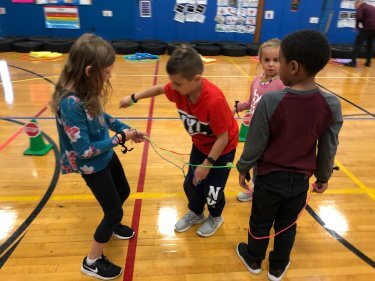
Social-Emotional Learning (SEL) in Action
I am always looking for creative and unique ways to teach about the mind-body connection and SEL (Social Emotional Learning) skills in physical education. Since I enjoy creating Escape Rooms, I created an SEL Escape Room that is based on the CASTEL’s (Collaborative for Academic, Social, and Emotional Learning) 5 core competencies to teaching SEL. These 5 competencies include self-awareness, self-management, social awareness, relationship skills, and responsible decision making.
Activity 1: Emotional Chains
I started by tying each team of students up in handcuffs. I made these handcuffs out of elastic and string. I then gave instructions to the students on how to tangle themselves up. Once tangled, I told the students they were in an Escape Room. Then I told the students a story about George The Giant. I explained to the students that they were captured, placed in chains, and locked up by George the Giant. I also mentioned that George use to be a Gentle Giant. He was very sweet and kind but then one day something happened. George let his emotions get built up and he just erupted! He became so angry and out of control! George became the Grizzly Giant. The emotions bothering George became his chains. He kidnapped all the students in Sayville, locked them up in these chains and wouldn’t let them return home. I then instructed each group to work as a team to help untangle the emotional chains that George had placed them in.
The objective of this game was to teach my students how our emotions can feel like chains and the only way we can break free of these chains is by sorting out our feelings and learning coping skills to help us handle our emotions. When they broke out of the chains, they were given a clue to the next code and instructions to the next activity.
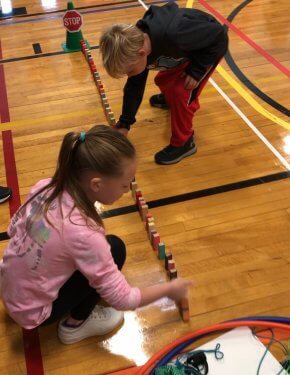
Activity 2: Domino Effect
The students were then instructed to create a “domino effect” showing George how his display of emotions have affected all of us. The students had to perform different locomotor skills as they raced around the gym collecting domino pieces. They had to follow the clues and eventually create a “domino effect” starting at their team base and ending at the finish cone, where a key to the next lock was hidden. This activity teaches the students that we have the exceptional power to feel and that our emotions run the gamut from sad to happy and everything that lies in between. These emotions are waves of energy, but they don’t just affect us; they impact others around us, and still others that those initial people encounter. What you feel and give off radiates all around you. It touches those closest to you and then makes its way to those beyond that initial circle. In other words, we have the capacity to not only feel but to impact others with our display of emotions. These “dominos” represent those people we can affect with our displays of emotion.
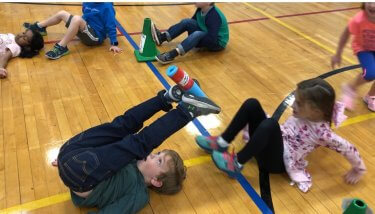
Activity 3: Labeling Emotions
The next clue gave each team a handout of pictures of children displaying different emotions. The teams will try to label these emotions. Posters representing each of the 6 core emotions (Anger, Fear, Surprise, Happy, Disgust, Sad) were hung around the gym. Underneath each of these 6 core emotions posters, I created a color chart of the different shades of those emotions. The shades of emotions chart help narrow down each of the core emotions. As the colors get darker, the emotions become more specific. For example, the core emotion of anger was the color red. The shades of emotions chart underneath anger started pink with the word hurt and as each emotion on the chart became more specific, the color intensity increased. The end emotion was “Hostile” and the color was deep red.
The students will try to correctly identify the emotion in the picture. If the students label the emotions correctly, they will find the code to open the next lockbox. The objective of this activity is to teach the students that to deal effectively with emotions we must first name them. Labeling emotions helps us develop control over them. Being able to accurately identify them is essential to creating a plan to resolve those feelings. We can’t create a plan or decide on coping strategies if we haven’t labeled our feelings accurately.
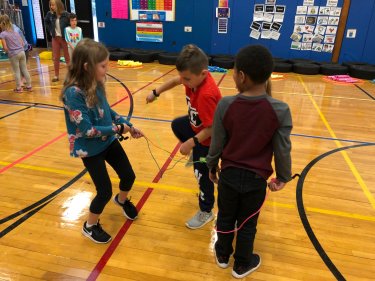
Activity 4: Learning to Focus
In the next activity, the students were told that George “lost his noodles”. The students had to help George “find his noodles” and help George “gather his thoughts”. I placed swimming pool noodles on the opposite side of the gym. The students were given different teamwork tasks to help move the noodles back to the opposite side of the gym. Once all the noodles were back, the students were given a puzzle to solve. The puzzle had instructions written on it. The instructions said for the students to help teach George the difference between things he can control and things he can’t control. On half of the noodles I wrote examples of things we can control such as how many times we smile today, our effort, time spent worrying, how we act on our feelings, etc. On the other half of the noodles, I wrote examples of things we can’t control such as the weather, what others say, what others feel, your past, your brother/sister, etc. The students had to sort the noodles into two piles: things we can control and things we can’t control. The code was written on the noodles with the things we can control.
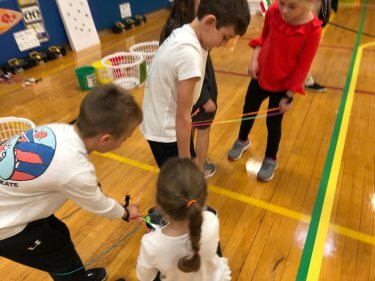
The objective of this activity was to teach students that sometimes we have a lot of things going on at one time and it’s hard to focus. We need to gather our “noodles” or thoughts and sort through them. Which ones do we have power over? Which ones can we control? Which ones can’t we control? If we have no power over it then why do we waste so much time worrying or thinking about those things? This activity is an opportunity to teach students that they may not be able to prevent something, but they can control how they prepare for it. In addition, they can’t control how someone else behaves, but you can control how you react. We can teach students to focus on their choices and we can help them develop effective strategies to manage their stress.
Activity 5: Coping Skills
Next, the students went on a scavenger hunt to help George find some effective coping skills. The students raced around the gym looking for pictures I made of different ways we can cope with our emotions. Some of these ways included exercise, listening to music, talking to a friend or adult, doing mindful breathing techniques, naming three things you are grateful for, etc. When the students found all the coping strategies, it led them to their final activity.
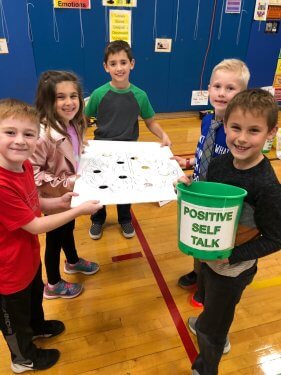
Activity 6: Positive Self-Talk
For the final task, I drew a giant brain on the poster board and cut out holes a little smaller than the size of ping pong balls. On some balls, I wrote examples of positive self-talk and on some balls I wrote examples of negative self-talk. The students had to first sort through the balls and separate them into a pile of positive self-talk and a pile of negative self-talk. The students had to “fill the brain” with positive self-talk. The team would work together to try to tip the board to get the ball to land into a hole in the brain. Once successful, they would move on to a new ball. When the brain was “full of positive self-talk” they would find the clue to the final box. Inside the final box, was a thank you letter from George for restoring him to his gentle ways and a thank you gift for the class. The thank-you gift was a class “Coping Toolkit” the students could use to prevent them from ever turning into George the Grizzly Giant. Inside the toolkit was crayons, a drawing pad, fidgets, stress balls, aromatherapy bags, bubbles, breathing beads, mindful snow globes, putty, and puzzles.
As teachers, we have a lifelong effect on our students. This impact involves not only the teaching of particular academic skills, but the fostering of students’ social-emotional skills. I hope my students always remember that they need to be their biggest cheerleader. That their self-thoughts have the most impact on their actions. I hope I inspire my students to believe in themselves, challenge their inner negative thoughts and change them to positive affirmations. I hope my students learn to fall, to fail, and to rise and try again. I want them to understand that they have the power to be all they dream of becoming. What do you hope they will remember from you?
For more information, search for @Coach Bolger’s Power PE. Here you will find my teaching resources and this SEL Escape Room with all activities and posters.

Coach Bolger is the ultimate role model for her students and her colleagues. Her creativity inspires lessons that completely engage all students. We are so lucky to have her at Lincoln Avenue Elementary School!
Not enough positive things can be said about Beth! Her energy, enthusiasm and passion for PE is limitless. If you ever have a chance to observe her classes or participate in one of her workshops, please do so!
Based on the last two articles on this site that I read that were written by Beth, I would have to agree with the last two commenters. Beth rocks! Too bad I’m retiring this year and won’t have an opportunity to put into practice what Beth teaches. At least not in my PE classes. I will try to in other areas of my life. Thanks Beth.
Thank you John for your sweet comments!! Enjoy retirement and stay healthy!!!
Beth, I would love to share your ideas in the G.A.M.E.S. Gazette, an online digital quarterly journal through teachers helping teachers. The Gazette is particularly geared to grades K-6 and I am the social emotional editor. I love what you created for your students in social emotional learning activities. You would be cited for complete credit and you would receive a free edition of the gazette. Please let me know if you feel I could use some of your material. Thanks so much.